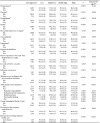References
1. Macintyre S. The Black Report and beyond: what are the issues? Soc Sci Med 1997;44(6):723–745.
2. Loucks EB, Magnusson KT, Cook S, Rehkopf DH, Ford ES, Berkman LF. Socioeconomic position and the metabolic syndrome in early, middle, and late life: evidence from NHANES 1999-2002. Ann Epidemiol 2007;17(10):782–790.
3. Kim HR. Implication of health behaviors in socioeconomic health inequalities and policy directions. Health Welf Policy Forum 2009;149:36–47.
4. Son M. The relationship of social class and health behaviors with morbidity in Korea. Korean J Prev Med 2002;35(1):57–64.
5. Lee SK. Social contextual effects on regional mortality and self-rated health status [dissertation] Seoul: The Graduate School, Yeonsei University; 2002. Korean.
7. Kim JY. The relationship between socioeconomic status and health in Korea: focusing on age variations. Korean J Sociol 2007;41(3):127–153.
8. Kim YM, Jung-Choi KH. Socioeconomic inequalities in health risk factors in Korea. J Korean Med Assoc 2013;56(3):175–183.
9. Lee JM, KIm WJ, Sohn HS, Chun JH, Lee MJ, Park HS. Influences on health behaviors execution and self rated health as socioeconomic class by the age bracket. J Korea Contents Assoc 2012;16(9):317–327.
10. Kim M, Chung W, Lim S, Yoon S, Lee J, Kim E, et al. Socioeconomic inequity in self-rated health status and contribution of health behavioral factors in Korea. J Prev Med Public Health 2010;43(1):50–61.
11. Ham OK, Kim BJ, Lee YA. Cardiovascular Disease Risk according to Socioeconomic Factors among Low-income Midlife Women. J Korean Public Health Nurs 2008;22(1):27–38.
12. Kang HM, Kim DJ. Gender differences in the association of socioeconomic status with metabolic syndrome in middle-aged Koreans. Korean J Med 2012;82(5):569–575.
13. Adler NE, Boyce WT, Chesney MA, Folkman S, Syme SL. Socioeconomic inequalities in health. No easy solution. JAMA 1993;269(24):3140–3145.
14. Yoon TH, Moon OR, Lee SY, Jeong BG, Lee SJ, Kim NS, et al. Differences in health behaviors among the social strata in Korea. Korean J Prev Med 2000;33(4):469–476.
15. Kim HR. The relationship of socioeconomic position and health behaviors with morbidity in seoul, Korea. Health Soc Welf Rev 2005;25(2):3–35.
16. Kim YA, Oh KW. Public health weekly report Osong: Korea centers for disease control and prevention; 2015. p. 33–36.
17. Lahelma E, Valkonen T. Health and social inequitiesin Finlandand elsewhere. Soc Sci Med 1990;31(3):257–265.
18. Liu J, Grundy SM, Wang W, Smith SC Jr, Vega GL, Wu Z, et al. Ten-year risk of cardiovascular incidence related to diabetes, prediabetes and the metabolic syndrome. Am Heart J 2007;153(4):552–558.
19. Seo JM. Gender differences in association between socioeconomic status and incident metabolic syndrome in Korean adults [dissertation] Cheongju: Chungbuk National University; 2015. Korean.
20. Dallongeville J, Cottel D, Ferrières J, Arveiler D, Bingham A, Ruidavets JB, et al. Household income is associated with the risk of metabolic syndrome in a sex-specific manner. Diabetes Care 2005;28(2):409–415.
21. Marquezine GF, Oliveira CM, Pereira AC, Krieger JE, Mill JG. Metabolic syndrome determinants in an urban population from Brazil: social class and gender-specific interaction. Int J Cardiol 2008;129(2):259–265.
22. Brown AF, Ettner SL, Piette J, Weinberger M, Gregg E, Shapiro MF, et al. Socioeconomic position and health among persons with diabetes mellitus: a conceptual framework and review of the literature. Epidemiol Rev 2004;26:63–77.
23. Loucks EB, Rehkopf DH, Thurston RC, Kawachi I. Socioeconomic disparities in metabolic syndrome differ by gender: evidence from NHANES III. Ann Epidemiol 2007;17:19–26.
24. Kim MH, Cho YS, Uhm WS, Kim S, Bae SC. Cross-cultural adaptation and validation of the Korean version of the EQ-5D in patients with rheumatic diseases. Qual Life Res 2005;14(5):1401–1406.
25. Kim JH. The relationship among socioeconomic status, health behavior, and self-rated health status in employees: gender difference. Korean J Health Educ Promot 2011;28(1):57–67.
26. Kim YS. Equity in health status and health care utilization by income: analyzing different populations in old adults. Health Soc Sci 2012;31:55–81.
27. Lee YJ. A equity in health care utilization by health statuss. Korea Soc Policy Rev 2010;17(1):267–290.
28. Korea centers for disease control and prevention. The Third Korea National Health and Nutrition Examination Survey Guide Book. KNHANES III 2005 [Internet] Osong: Korea centers for disease control and prevention; 2006. Accessed Jan, 2014. Available form:
https://knhanes.cdc.go.kr/knhanes/sub03/sub03_02_02.do.
29. House JS, Laritz PM, Herd P. Continuity and change in the social stratification of aging and health over the life course: Evidence from a Nationally Representative Longitudinal Study from 1986 to 2001/2002(American's Changing Lives Study). J Gerontol B Psychol Sci Soc Sci 2005;60(Special_Issue_2):S15–S26.




